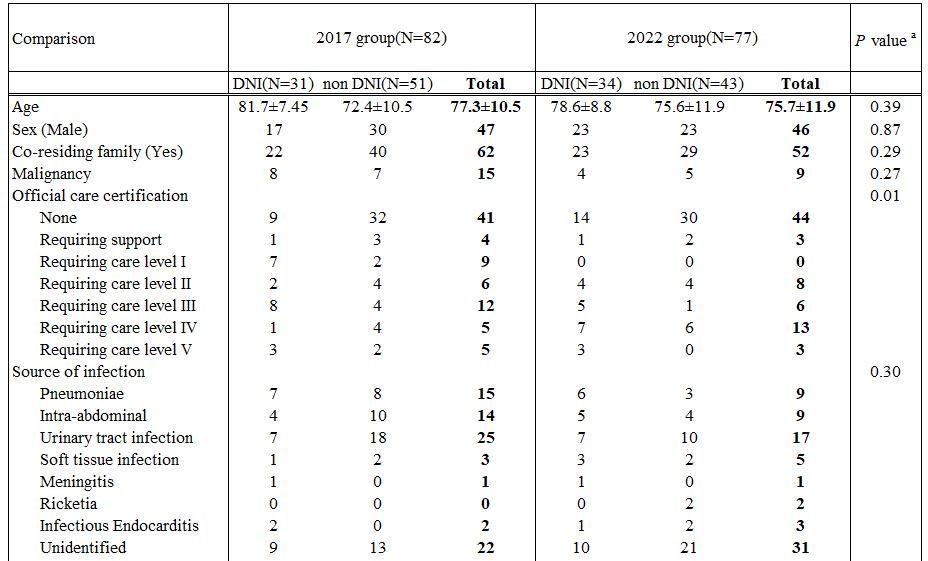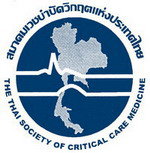Retrospective comparison of the frequency of Do Not Intubate orders among patients diagnosed with sepsis in the emergency room between 2017 and 2022
DNIs among patients with sepsis in the ER
DOI:
https://doi.org/10.54205/ccc.v32.266787คำสำคัญ:
Do not intubate order, Emergency room, Sepsisบทคัดย่อ
Background: This study retrospectively evaluated the frequency of "Do Not Intubate" (DNI) orders in patients with sepsis diagnosed in the emergency room in 2017 and 2022. The objective was to understand the longitudinal adoption of the Advanced Care Planning (ACP) concept over a 5-year span.
Methods: We included patients primarily diagnosed with sepsis by emergency physicians at Kurashiki Central Hospital in 2017 and 2022. The primary outcome was the frequency of DNI orders, whereas the secondary outcomes were morbidity and length of hospital stay. We compared the outcomes between 2017 and 2022. Additionally, patient characteristics, such as age, sex, presence of co-resident family members, malignancy status, source of infection, and degree of official care certification were collected.
Results: We included 82 and 77 patients with sepsis in 2017 and 2022, respectively. Regarding the primary outcome, 39% (95% confidence interval [CI]: 27-49%) (31/82) of patients with sepsis in 2017 had DNI orders, compared to 44% (95% CI: 33-56%) (34/77) in 2022. There were no significant differences in the primary and secondary outcomes between the two years. The only significant difference noted was in the degree of official care certification among patient characteristics.
Conclusion: The frequency of DNI orders remained relatively stable between 2017 and 2022. This suggests that the ACP concept has not yet been widely integrated into the decision-making process for treatment strategies for patients with sepsis.
Downloads
เอกสารอ้างอิง
Evans L, Rhodes A, Alhazzani W, Antonelli M, Coopersmith CM, French C, et al. Surviving sepsis campaign: international guidelines for management of sepsis and septic shock 2021. Intensive Care Med. 2021;47:1181-247.
Brun-Buisson C. The epidemiology of the systemic inflammatory response. Intensive Care Med. 2000;26 Suppl 1:S64-74.
Angus DC, Linde-Zwirble WT, Lidicker J, Clermont G, Carcillo J, Pinsky MR. Epidemiology of severe sepsis in the United States: analysis of incidence, outcome, and associated costs of care. Crit Care Med. 2001;29:1303-10.
Martin GS, Mannino DM, Eaton S, Moss M. The epidemiology of sepsis in the United States from 1979 through 2000. N Engl J Med. 2003;348:1546-54.
Inoue S, Nakanishi N, Sugiyama J, Moriyama N, Miyazaki Y, Sugimoto T, et al. Prevalence and long-term prognosis of post-intensive care syndrome after sepsis: a single-center prospective observational study. J Clin Med. 2022;11.
Japan, Ministry of Health, Labour and Welfare. Available from: https://www.mhlw.go.jp/content/000988388.pdf. Published October 13, 2022. (in Japanese)
Japan, Ministry of Health, Labour and Welfare. Available from: https://www.mhlw.go.jp/stf/houdou/0000197665.html. Published March 14, 2018. (in Japanese)
Rubins JB. Use of combined do-not-resuscitate/do-not intubate orders without documentation of intubation preferences: a retrospective observational study at an academic level 1 trauma center code status and intubation preferences. Chest. 2020;158:292-7.
Mirarchi FL, Juhasz K, Cooney TE, Puller J, Kordes T, Weissert L, et al. TRIAD XII: Are patients aware of and agree with DNR or POLST orders in their medical records. J Patient Saf. 2019;15:230-7.
Kuriyama A, Ikegami T, Kaihara T, Fukuoka T, Nakayama T. Validity of the Japan Acuity and Triage Scale in adults: a cohort study. Emerg Med J. 2018;35:384-8.
Kanda Y. Investigation of the freely available easy-to-use software 'EZR' for medical statistics. Bone Marrow Transplant. 2013;48:452-8.
Jayes RL, Zimmerman JE, Wagner DP, Draper EA, Knaus WA. Do-not-resuscitate orders in intensive care units. Current practices and recent changes. JAMA. 1993;270:2213-7.
Cheng MT, Hsih FY, Tsai CL, Tsai HB, Tsai DF, Fang CC. Increased rate of DNR status in hospitalized end-of-life patients in Taiwan. Intensive Care Med. 2016;42:1816-7.
Chang YC, Fang YT, Chen HC, Lin CY, Chang YP, Chen YM, et al. Effect of do-not-resuscitate orders on patients with sepsis in the medical intensive care unit: a retrospective, observational and propensity score-matched study in a tertiary referral hospital in Taiwan. BMJ Open. 2019;9:e029041.
Standards for cardiopulmonary resuscitation (CPR) and emergency cardiac care (ECC). V. Medicolegal considerations and recommendations. JAMA. 1974;227:Suppl:864-8.
American College of Emergency Physicians Ethics Manual. Ann Emerg Med. 1991;20:1153-62.
Rueda FEG, Hoyos AS, De La Paz Echeverri ML, Balocco ALB, Parra AMM. Frequency of Do-Not-Resuscitate Orders in a Level 4 University Hospital. Universitas Medica. 2018; 59.
van Delden JJ, Lofmark R, Deliens L, Bosshard G, Norup M, Cecioni R, et al. Do-not-resuscitate decisions in six European countries. Crit Care Med. 2006;34:1686-90.
Huang CT, Chuang YC, Tsai YJ, Ko WJ, Yu CJ. High Mortality in Severe Sepsis and Septic Shock Patients with Do-Not-Resuscitate Orders in East Asia. PLoS One. 2016;11:e0159501.
Powell ES, Sauser K, Cheema N, Pirotte MJ, Quattromani E, Avula U, et al. Severe sepsis in do-not-resuscitate patients: intervention and mortality rates. J Emerg Med. 2013;44(4):742-9.
Dong J, Chen R, Song X, Guo Z, Sun W. Quality of life and mortality in older adults with sepsis after one-year follow up: A prospective cohort study demonstrating the significant impact of frailty. Heart Lung. 2023;60:74-80.
Singer M, Deutschman CS, Seymour CW, Shankar-Hari M, Annane D, Bauer M, et al. The Third International Consensus Definitions for Sepsis and Septic Shock (Sepsis-3). JAMA. 2016;315:801-10.

ดาวน์โหลด
เผยแพร่แล้ว
รูปแบบการอ้างอิง
ฉบับ
ประเภทบทความ
สัญญาอนุญาต
ลิขสิทธิ์ (c) 2024 สมาคมเวชบำบัดวิกฤตแห่งประเทศไทย

อนุญาตภายใต้เงื่อนไข Creative Commons Attribution-NonCommercial 4.0 International License.




